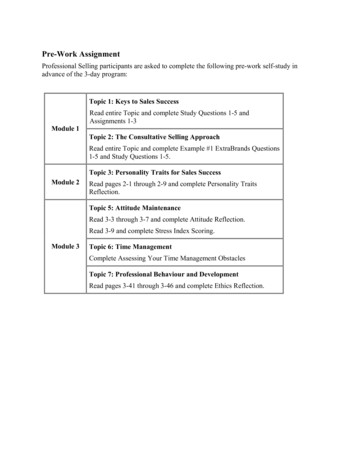
Transcription
Thinking of Selling Your Home?Ready. Set. Sell.
Table of Contents1. Welcome to the Game: Discovering Your Why2. Game Prep: Get Serious About the Finances3. Working with a Coach: Your Real Estate Agent4. Pre-game: Tackle Your “To-Do” List5. Prepping the Field: Staging Your Home7. Checking the Equipment: Cleaning House8. Let the Games Begin: Negotiation Time9. The Last Play: Inspections10. The Final Timeout: Waiting for the Closing11. Happy Selling
Welcome to the GameDiscovering Your WhyThere are many reasons why you’d choose to sell your home. Maybe you’ve got equity on your side and youwant to find a place that better fits your lifestyle. Or, perhaps your family has outgrown your current spaceand you’re ready for some breathing room. Whatever your “why,” it’s important to evaluate your current “painpoints” and how they’ll shape your game plan:The SpaceThe MoneyThe Why Not?If you or your family has outgrown yourcurrent place, selling can help you upgrade to a more spacious residence.The same is true in the reverse; if yourfamily now has too much space, perhaps from retirement or kids leavingthe nest, then downsizing may be thebest fit. If space is your “why,” it’s important to prioritize square footage inyour next home search and to evaluatethe number of bedrooms, bathrooms,common spaces that are “must haves.”Be sure to pass these along to youragent!We get it.homeownership can be costly! The monthly expenses, upkeep and-heaven forbid- any emergency repairsor natural disasters can really depletethe bank account. If this is your “why,”figure out what type of home would bemost appropriate for your next place.Would a homeowner’s association bebest to help manage upkeep? Woulda newer construction home, with presumably less wear and tear, providemore peace of mind? Talk with youragent about your concerns and get hisor her input on what would make sensefor your next home.Looking for a challenge with a fixer upper rather than the new constructionhome you bought? Have enough equitybuilt in your home to cash out and travel the world? Whatever has you asking“why NOT sell?” is just enough reasonto join the game, assuming you’ve factored your risk tolerance. Speaking to areal estate professional will help guideyou on whether selling is the right movebased on market conditions, financesowed on the house and fair marketvalue.Perhaps your reasons to consider selling are different than the ones listed here. Whatever they are, theprimary goal is to identify them and figure out how they’ll impact your next steps.Back to table of contents
Game PrepGet Serious About the FinancesNow that you’ve figured out your “why,” there are a few financial things to consider. Are you underwateron your mortgage? What’s the current market like and how might it impact your ability to sell?What price point can you list for?Are you on top or underwaterwith the house?In real estate, “underwater” refers towhen a homeowner owes more ontheir home than the home is actually worth. If you’re unsure of whetheryou’re underwater, you can usuallydetermine this by contacting the financial agency responsible for handling your mortgage.What can you reasonably sellit for?Now you’re ready to ask the million-dollar question: “How much canI sell my home for?” A simple way tofind out is to use the Home Value Estimator by Homes.com, which will giveyou an estimate of the monetary value of your home in the current market.Understandably, you want to get thebest price for your home. Just remember to be realistic in your askingamount, because what you can sell itfor and should sell it for aren’t alwaysequal.To determine how much you shouldsell your home for, request your agentto provide a Comparative MarketingAnalysis (CMA). This report providesdata of the most recent sales in yourarea and can help you compare thosevalues to the value of your home.You can also determine the listingprice of your home based on the inventory or current market conditions.In a buyer’s market, you may have toprice your home slightly lower thanthe value price to get your home tosell. In a seller’s market, you can priceyour home no more than 10 percentabove market value. In a neutral market, you need to pay close attentionto the home sale prices in your neighborhood to make sure that you areable to price your home just right toguarantee a sale.The first step to answering these questions is requesting your agent provide a home value report or amarket analysis of your home.Back to table of contents
Working with a CoachYour Real Estate AgentWhether your priority is selling your home quickly or getting the highest offer, a real estate agent cancoach you to success.Finding the Right Coach for YouThe best agent for someone else isn’t necessarily the best agent for you, and sinceyour agent will be the driving force behinda successful transaction it’s important tofind one you can establish a good rapportwith. How? Read on .Do Your ResearchIt might be tempting to save time, butdon’t automatically use the first agent youfind. First, consider location. Researchagents in your area and find eight to tenwho work nearby or have experience withhomes in your area. Use online reviewsfor their services to narrow your list downto the best four or five agents. Next, seewho has strongest presence in places likeHomes.com, social media, and their ownwebsites. Since they’ll be marketing yourhome, you want to make sure they’reequipped to give your home the greatestexposure possible.Conduct InterviewsAgent interviews will help you figure outthe traits you value in a working relationship and to find someone who suits yourstyle. Ask questions to determine personality traits, skills and experience. Somehelpful questions might be how manyclients they’re currently representing, ifthey’d be working with you directly, if theyhave a team, and what sets them apartfrom the competition. After interviewing afew agents, you should have a good ideaof who you want to work with.CommitAll that’s left is to call up your chosen agentand get to work! They’ll have some paperwork for you to fill out, and then they‘llbe ready to help you figure out what youneed to get your home ready to sell.Working with an agent is not required to sell your home. But, as you might imagine, homeowners who listwithout an agent typically sell their homes for less than the selling price of agent-listed homes and canhave a more difficult time finding a buyer.**Agent-assisted sales have a median selling price 32% higher than homeowners who list on their own. (2018 NAR Profile of Home Buyers and Sellers)Back to table of contents
Pre-gameTackle Your “To-Do” ListWith your agent’s help, you can tackle the projects that are“must haves” and the “nice to haves” to get your home on themarket. Your agent will have insider knowledge on what buyerswill focus on, so listen to your coach! Getting your home readyfor sale can feel more like a renovation, but it doesn’t have towith our easy room-by-room guide. Here are some tips to getthe crowd pumped to buy before they even set foot inside!KitchenBathroomsLiving Areas/DoorsOO Repair or replace faultyappliancesOO Replace and update outletsOO Ensure all vents and exhaustfans work or are up to codeOO Repair or replace brokencountertops, cabinets orflooring, and any leaky faucetsOO Fix any leaky faucets andnon-functioning commodesOO Remove any signs of mold orwater damageOO Repair or replace any broken ormissing tilesOO Replace exhaust fan if neededOO Repair or replace broken windowsOO Recaulk windows if neededOO Install new weather stripping ondoorsOO Paint the front doorOO Spackle cracks or holes in thewalls and ceilingsNice to HaveNice to HaveNice to HaveOO Upgrade lighting fixturesTip: This can brighten up yourspace and give the perception ofa full upgrade!OO Update hardware whereapplicableOO Add a backsplashOO Remove any build-up from drainsand faucetsOO Regrout the bathtubOO Replace fixtures like the sink,vanity, commodesOO Fresh coat of paintTip: This can give the appearance ofa remodel without all of thehard work!BedroomsOutdoorsMust HaveMust HaveOO Repair or replace broken windowsOO Organize closetsOO Remove all furniture except forbed, bedside tables, and dressersNice to HaveOO Replace fansOO Fresh coat of paintOO Create a walk-in closetTip: Choose window dressings thatmake the room look bigger!Back to table of contentsMust HaveMust HaveOO Replace any loose or broken deckboards, railings, and any brokenor missing roof tilesOO Remove any dead plants or treesOO Replace any missing exteriorlightingNice to HaveOO Power wash applicable exteriorsurfacesOO Overhaul roof for added valueOO Add seasonal plants to exteriorOO Update house numbersMust HaveOO Replace fansOO Remove popcorn ceilingsOO Add architectural moldingOO Fresh coat of paintTip: Stick to neutrals for any freshpaint in the house.OO Update flooringTip: Buyers love the phrase“hardwood flooring throughout!”REMEMBER:Buyers will most likely do ahome inspection, so makesure you cover all “basics” toavoid any delays.
Prepping the FieldStaging Your HomeThe longer a house sits on the market, the more likely buyers might think there’s somethingwrong with it. Decluttering and staging your home can protect you from that dreaded fateby showing buyers the full potential of the space. After all, buyers aren’t just looking for ahouse; they’re looking for somewhere to call home .There’s No “I” in “Team”Buyers will struggle to see themselves in your homeif it’s full of personal belongings like photos and collections. Remove those items and give your wallsa fresh coat of paint in a neutral color. Minimizetraces of your pets by deep cleaning carpets, wiping down walls, and addressing any potential lawnimpacts. (Remember to bring them with you whenyou leave for a scheduled showing or your agenthosts an open house!)Declutteringattention to the contents of your cupboards andclosets as this is premium space. Remove anynon-essential toys, books, shelves, clothes, storagecontainers and kitchen ware, and rent a storagespace where you can keep them.Living RoomThis space should be a top staging priority. When planning yourstaging here, keep the phrase “room to grow” in mind, leavingplenty of room on the walls and around furniture to make it seemmore spacious.WelcomingStaging is all about giving a first and lasting impression, so be sure to make each space of yourhouse, including the yard, as inviting as possible.Keep things simple and neat, and use sources likePinterest or the Homes.com blog for inspiration.Remove extra furniture and replace bulky itemswith slimmer pieces of furniture. Pay particularKitchenBack to table of contentsPack up all small appliances and clear the fridge of coupons,magnets, personal bulletins, etc. Clear kitchen drawers andcabinets of non-essential items to make them look as spaciousas possible. Once the clutter is gone, consider adding some colorwith a bowl of seasonal fruits or a vase of fresh flowers.
Master BedroomDining RoomBathroomOutdoorsWhen staging your master bedroom,the only things touching the floorshould be furniture and maybe a rug.Most bedrooms don’t need muchmore than the bed, dresser, end tables, and a mirror. Make sure the furniture is cleared of all personal items.Remove any TVs, laundry baskets,and anything visible under the bed.Place nice decorative lamps on theend tables and make sure the bed isneatly and attractively made.The dining room is where familiescome together! However, this room isoften home to large, heavy furniture.Make the space feel more open andbright with a nice centerpiece andsome simple but attractive place-settings. Just be careful not to make thetable feel cluttered. If the table seatssix, lay out four places. If it seats four,lay out two. Remove any extra chairsthat are gathered around the roomand, if you need to, incorporate extralighting.While the bathroom can be small,it’s far from unimportant. Here, themain priority is making sure everyinch is spotless. Everything from thetub to the walls should look fresh andclean. Remove all but the barest necessities in the vanity and tub itself,and put out fresh towels and rugs.Adding a few decorative candles orjars will help create a more spa-likeenvironment.Your home’s exterior is the first thinga buyer sees when they pull intoyour driveway. Make sure the lawn isfreshly mown, bushes are trimmed,and the driveway is smoothly pavedand clear of leaves and weeds. Cleanthe windows and be sure to have aninviting threshold. If necessary, giveyour home a thorough cleaning witha pressure washer.Final Staging Tip: Opening the blinds and turning on the lightsin your home will make your home brighter and more appealingduring a showing.Back to table of contents
Checking the EquipmentCleaning HouseGreat staging simply won’t be effective if your furniture and decor are covered in dirtydishes, laundry, or dust, so make sure your home is as clean as possible at all times in casebuyers decide to visit come at a moment’s notice. Here’s a comprehensive checklist to helpget, and keep, your home presentation-ready!Throughout the HouseBathroomOutdoorsWipe downOO Scrub tub/shower, sinkOO Remove cobwebsOO WallsOO WindowsOO Ceiling fixturesOO Air ventsOO Switches and outletsOO DoorsWashand toiletOO Wash soap dispenser andother counter itemsOO Wash or replace showercurtain and linerOO Polish faucets and fixturesOO Clean out guttersOO Replace old mulchOO Rake up leavesOO Sweep decks/patios/drivewayOO Clean welcome matsPressure washKitchenOO House exterior wallsOO Carpets/floors/rugsOO Clean out fridgeOO Deck/patioOO Inside/outside of fireplaceOO Wash all appliances (inside and out)OO CurtainsWipe Dust/polishOO BookshelvesOO BlindsOO Wipe down cabinets and countertopsOO DrivewayOO Lawn furnitureOO De-grease hood ventOO Wash and put away dishesEVERY. SINGLE. DAY.OO FurnitureOO Door knobsOO Faux plantsOO Clean out litter boxOO Change air filterOO Put away laundryOO Clean/deodorize trash cansBack to table of contents
Let the Games BeginNegotiation TimeIn the game of home buying, it’s buyers versus sellers. Offense anddefense. And to win, both sides want to walk away with the best pricefor the home.The buyer’s first offer is the opening kickoff, and the next playsdetermine everyone’s margin of victory. As the seller, you might befaced with any number of scenarios so always be as prepared aspossible with a strong game strategy. Here are a few examples:The Counter Run: Counteroffer the Asking PriceExpecting a negotiation process, the buyer has offered a low bid. You know you’vepriced your home fairly, so run the ball back in the right direction by counteringwith the asking price or a reasonable compromise. It might dissuade some folksfrom staying in the game, but it will also ensure the remaining players are in it towin it.The Hail Mary: Ask for a Different OfferIt’s a riskier approach, but can pay off. Instead of making a counteroffer, don’tmake an offer at all. Reject the buyer’s offer and request they submit a new one.As stated, this is definitely a risky option, and one we’d recommend you consultyour real estate professional on first.The Blitz: Set Time LimitsRemember, once negotiations begin with a buyer, you cannot accept otheroffers that come your way. If you’re eager to sell, setting an expiration limit onyour counteroffer will force the buyer to make a more expedited decision onany next decisions.Throw in Some PerksIf the offer seems too low, it could indicate the buyer is concerned with closingcosts or potential necessary repairs. If you want a higher bid, it could work in yourfavor to offer some perks with the purchase. A washer and dryer unit, coveringthe first-year home warranty, or throwing in the hot tub can soften the financialblow for the buyer, particularly if this is their first home purchase experience.Back to table of contents
The Last PlayInspectionsYou’re in the home stretch. Your potential buyer has accepted the offer, so now it’s time to initiate the inspectionprocess. If you followed our tips in previous sections, this should be only a minor hurdle to the finish line!What’s a Home Inspection?A home inspection is performed by aprofessional consulting company tohelp determine the current condition ofyour home’s major systems like heatingand cooling, drainage, etc.Tip: Get a home inspectiondone before listing yourhome so there will be nosurprises when it’s time forthe “real” one.The potential buyers typically hire theinspection company, after which theyhave about seven to ten days to get itdone. In some cases, a mortgage lenderwill not proceed with the loan withoutan inspection. The inspection itself cantake from two to five hours, dependingon the size of the property. The seller(you) is typically not present for it butyour agent is there to act as your liaisonand can answer any questions aboutthe property.After the InspectionOnce the home inspection is complete,the buyer will be presented with a detailed list of the team’s findings, bothpositive and negative. This list will include both minor and major items likea bathtub scuff, missing roof tiles or afaulty HVAC system.At this point, the buyers can make oneof three choices:2. Present you with a list of repairs to bemade before moving forward withthe transaction.3. Negotiate the price of the homebased on the inspection findings.If the buyer chooses option two, you cannegotiate with them on what repairsyou will and will not address to move thetransaction forward. Be warned, however, that the buyers could still back outat any time.1. Back out of the transaction.Once you’ve both agreed on terms of the inspection, you’re one step closer to closing!Back to table of contents
The Final TimeoutWaiting for the ClosingCongratulations — both you and the buyer have accepted the offer. Score! Now comes the timeout before theclosing date. Use this period to prepare the home for its soon-to-be new owner.Revisit or Update Your Game PlanClean Out Your LockerGrab Your GearSelling a home involves much more than paperwork. Without a plan, things like coordinatingyour move and transferring utilities can sneakup on you. Here are some tips:Once you’ve completely moved out of thehome, it’s time for the finishing touches:To prevent a delay of game, preparethese documents to bring with youto closing: If you’re planning to use a moving compa-ny, get a few quotes from reputable onesin your area. Pay special attention to pricing strategies; for example, if a companycharges by weight and you own a home gym,you might consider selling your equipmentprior to moving or using a different company. Be sure to research any fine print. Utilities will need to be transferred to the Double-check all storage spaces tomake sure items haven’t been leftbehind and lights are turned off. Addressany necessary repairs ornegotiated property changes. Givethe home a final, thoroughcleaning inside and out. A photo ID The deed to the home Documentation of repairs The key or security codeto the front door Label all keys to the property andleave them in a safe space like akitchen drawer.next owner prior to closing. If they won’t bemoving in for a while, be sure to shut off thewater to avoid possible pipe bursts.Back to table of contents
Happy SellingJust like your favorite sports matchups, selling your home willhave a few challenges and victories! But, with a solid strategy anda great coach, you’re sure to have the most positive outcome.Homes.com is rooting for your success; so, we encourage you to usethis guide as a game plan to meet all your home-selling goals.And, don’t forget to visit our blog for inspiration, DIY projects, andbudget-friendly ideas. Happy selling!DISCLAIMER:While this guide is comprehensive, it is not exhaustive. Everyone’sselling situation is unique, so always double-check with your agent andlocal municipality regarding housing laws and code requirements.Follow us for up-to-date news,information, and all things homes!Simply Smarter Home Search
sell your home for, request your agent to provide a Comparative Marketing Analysis (CMA). This report provides data of the most recent sales in your area and can help you compare those values to the value of your home. You can also determine the listing price of your home










